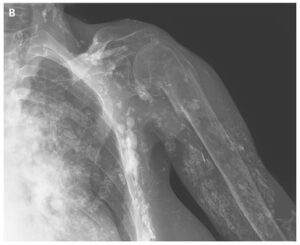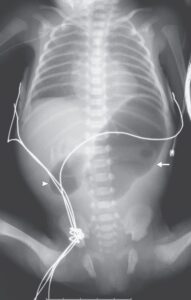This article is an answer to the Case – A Bleeding Painless Nodule
A shave biopsy of the skin revealed a pyogenic granuloma. Pyogenic granuloma, also known as lobular capillary hemangioma, is a benign vascular lesion of the skin and mucosa. These lesions are relatively common.
Epidemiology
Although pyogenic granulomas can occur at any age, they are more common in children and young adults, representing 0.5% of all skin nodules in children. Males and females are affected equally. There is no known racial predilection. Pyogenic granulomas on the gingiva are more common in pregnant women.
Etiology and Pathophysiology
The pathophysiology of pyogenic granuloma is unknown but is likely the result of reactive neovascularization. One-third of cases have a history of preceding trauma or irritation.
Recent genetic studies demonstrate increased protein expression in the nitric oxide pathway and FLT4 (a tyrosine kinase receptor), which is related to hypoxia-induced angiogenesis and vascular injury. Pyogenic granulomas may develop during pregnancy, so hormonal influences may also be a factor in the onset of this condition.
Medications that have been associated with the development of pyogenic granuloma include the following: antineoplastics (paclitaxel [Abraxane, Onxol, Taxol], docetaxel [Docefrez, Taxotere], capecitabine [Xeloda], mitoxantrone [Novantrone]), antiretrovirals (indinavir [Crixivan], lamivudine [Epivir], zidovudine [Retrovir]), epidermal growth factor receptor inhibitors (cetuximab [Erbitux], erlotinib [Tarceva], gefitinib [Iressa]), immunosuppressants (cyclosporine [Gengraf, Neoral, Sandimmune), and retinoids (acitretin [Soriatane], etretinate [Tegison], isotretinoin).
Clinical Presentation of Pyogenic Granuloma
Pyogenic granulomas present as a solitary red papule or polyp. There is often a history of rapid growth over weeks to months, after which time the lesion stabilizes. Pyogenic granulomas rarely grow larger than 1 cm, making the size in the case described here an unusual feature. Frequent and easy bleeding is often the presenting complaint when patients seek care for these lesions.
The most common sites in decreasing order of frequency are the gingiva, fingers, lips, face and tongue. Pyogenic granulomas can very rarely present in extracutaneous sites, including the GI tract, subcutaneous tissue, or within the veins. There is a case report of pyogenic granuloma developing in the stomach presenting with melena.
Subcutaneous pyogenic granulomas can present as a painful or a painless protruding nodule in the finger with easy bleeding on contact.
Intravenous pyogenic granulomas (IVPG) usually occur in the veins of the neck and upper extremities. Unlike cutaneous pyogenic granulomas, this condition is usually seen in adults. IVPG can present with an asymptomatic mass with or without focal swelling distal to the lesion secondary to venous occlusion.
Although pyogenic granulomas are usually solitary, disseminated and eruptive forms on the skin have occurred in the settings of burns and drug hypersensitivity reactions, within congenital vascular lesions, and in otherwise healthy patients.
Diagnosis of Pyogenic Granuloma
The diagnosis of pyogenic granuloma can usually be made by clinical exam. A skin biopsy can confirm the diagnosis and is often curative. The characteristic feature on skin biopsy is a well-circumscribed and exophytic proliferation of small capillaries that are divided into lobules by thick bands of fibrous tissue.
The lateral margins of the papule are often defined by epithelial collarettes from either peripheral adnexal hyperplasia or downward growth of rete ridges.2 Because these lesions are easily traumatized, there is often secondary ulceration. Pyogenic granuloma will demonstrate positive Wilms tumor 1 protein expression, a marker for vascular tumors.
Ultrasound findings of subcutaneous pyogenic granuloma have been described as hypoechoic and homogeneous masses with marked vascularity.
Differential Diagnosis
In infants, the differential diagnosis includes an infantile hemangioma. Hemangiomas are usually more plaquelike and often have a deeper-blue subcutaneous component.
In adults, pyogenic granulomas may rarely be confused with angiolymphoid hyperplasia with eosinophilia or amelanotic melanoma; however, these lesions can be distinguished from pyogenic granuloma by the lack of intense red color typically seen in vascular lesions.
In an immunosuppressed patient, bacillary angiomatosis or Kaposi sarcoma could be difficult to distinguish from a pyogenic granuloma. On the hands, the differential diagnosis includes acquired digital fibrokeratoma or glomus tumor.
An acquired digital fibrokeratoma is usually skin-colored, unlike pyogenic granulomas, which are red and vascular in appearance. Glomus tumors usually present as small blue papules, most commonly in subungual sites. With any of these entities, if a diagnosis cannot be made on clinical grounds, a skin biopsy is diagnostic.
Subcutaneous pyogenic granulomas might be confused with such other subcutaneous tumors as giant cell tumor of the tendon sheath, but the latter is hard and fixed to underlying structures. Since subcutaneous lesions are usually too deep to be sampled by skin biopsy, ultrasound and other imaging studies may be useful.
Treatment of Pyogenic Granuloma
Treatment of pyogenic granulomas can easily be achieved by shave, punch, or scalpel excision. Frequently, the shave biopsy is deep enough to also be curative; however, the rate of recurrence may be as high as 9.55%.
Although full-thickness excision has the lowest risk of recurrence among surgical options (2.94%), this must be weighed against the fact that excisions are more expensive, more time-consuming, and have the potential for more morbidity than a simple shave removal.
Nonsurgical options include:
- cryotherapy with liquid nitrogen
- laser therapy (CO2 laser, flashlamp-pumped pulsed dye laser)
- topical imiquimod (Aldara, Zyclara).
Cryotherapy was noted to have a low recurrence rate (1.62%), but required two sessions on average for removal of the lesion.
Both CO2 laser and flashlamp-pumped pulsed dye laser had recurrence rates of less than 5%, but the majority of patients undergoing flashlamp-pumped pulsed dye laser required more than one treatment for clearance. Patients who underwent CO2 laser only required one treatment.
Topical imiquimod 5% cream was used in a study of five pediatric patients with resolution of lesions within two to four weeks; however, imiquimod cream commonly causes significant local irritation that may limit patient compliance in general practice.
Although the nonsurgical options demonstrated low recurrence rates, shave removal is still the most common modality to treat pyogenic granulomas, as it is relatively inexpensive and requires only one clinic visit. The patient in this case was anesthetized with local injections of lidocaine, and his lesion was shave-removed and electrodesiccated with successful resolution.
References
- Patrice SJ, Wiss K, Mulliken JB. Pyogenic granuloma (lobular capillary hemangioma): a clinicopathologic study of 178 cases. Pediatr Dermatol. 1991;8:267-276.
- Bolognia JL, Jorizzo JL, Rapini RP, eds. Dermatology. 2nd ed. St. Louis, Mo.: Elsevier-Mosby; 2008:1776-1777.
- Godfraind C, Calicchio ML, Kozakewich H. Pyogenic granuloma, an impaired wound healing process, linked to vascular growth driven by FLT4 and the nitric oxide pathway. Mod Pathol. 2013;26:247-255.
- Paul LJ, Cohen PR. Paclitaxel-associated subungual pyogenic granuloma: report in a patient with breast cancer receiving paclitaxel and review of drug-induced pyogenic granulomas adjacent to and beneath the nail. J Drugs Dermatol. 2012;11:262-268.
- Kerr DA. Granuloma pyogenicum. Oral Surg Oral Med Oral Pathol. 1951;4:158-176.
- Kusakabe A, Kato H, Hayashi K, et al. Pyogenic granuloma of the stomach successfully treated by endoscopic resection after transarterial embolization of the feeding artery. J Gastroenterol. 2005;40:530-535.
- Lee GK, Suh KJ, Lee JH, et al. Lobular capillary hemangioma in the soft tissue of the finger: sonographic findings. Skeletal Radiol. 2010;39:1097-1102.
- Ceyhan AM, Basak PY, Akkaya VB, et al. A case of multiple, eruptive pyogenic granuloma developed on a region of the burned skin: can erythromycin be a treatment option? J Burn Care Res. 2007;28:754-757.
- Ghekiere O, Galant C, Vande Berg B. Intravenous pyogenic granuloma or intravenous lobular capillary hemangioma. Skeletal Radiol. 2005;34:343-346.
- Palmero ML, Pope E. Eruptive pyogenic granulomas developing after drug hypersensitivity reaction. J Am Acad Dermatol. 2009;60:855-857.
- Baselga E, Wassef M, Lopez S, et al. Agminated, eruptive pyogenic granuloma-like lesions developing over congenital vascular stains. Pediatr Dermatol. 2012;29:186-190.
- Lawley LP, Cerimele F, Weiss SW, et al. Expression of Wilms tumor 1 gene distinguishes vascular malformations from proliferative endothelial lesions. Arch Dermatol. 2005;141:1297-1300. Available at archderm.jamanetwork.com/article.aspx?articleid=399310.
- Lee J, Sinno H, Tahiri Y, Gilardino MS. Treatment options for cutaneous pyogenic granulomas: a review. J Plast Reconstr Aesthet Surg. 2011;64:1216-1220.
- Fallah H, Fischer G, Zagarella S. Pyogenic granuloma in children: treatment with topical imiquimod. Australas J Dermatol. 2007;48:217-220.


